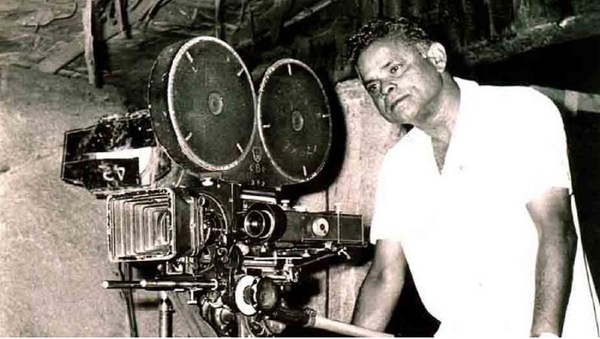Remembering Adurthi Subba Rao: A storyteller who brought class and dignity to mainstream Telugu cinema
We look back at Adurthi's tryst with cinema on his 109th birth anniversary

Last Updated: 04.06 PM, Dec 16, 2021
In Telugu cinema of the 1940s, when director Adurthi Subba Rao was making his baby steps into the industry, it was the folklore, mythology and devotional film genres that captured the imagination of the public. Social films, family dramas (set in the contemporary timeline) were gradually making an impression among audiences but were yet to enjoy a mass following. If the 1950s was a decade that marked the domination of social films in mainstream Telugu cinema, Adurthi Subba Rao's contribution had a lot of say in it.
The filmmaker, whose storytelling credentials are second to none in the Telugu industry, would've turned 109 if he were alive today. Born in Rajahmundry to a middle-class family, Adurthi Venkata Subba Rao was a happy-go-lucky youngster smitten by films. Interestingly, he was more of a technician in his early years, assisting in multiple departments. He started as a camera assistant in Bombay, learnt the ropes of editing under NK Gopal, even wrote lyrics for films like Okaroju Raju, Mangalasutram.
After assisting NK Gopal on the edit table for Uday Shankar's Hindi film Kalpana in 1948, he was a directorial assistant to KS Prakasa Rao for a film named Balanandam. Buoyed by encouragement from his friends S Bhavannarayana, D B Narayana, he co-founded the production house Saahini Pictures soon. Inspired by Kamal Amrohi's Baiju Bawra, they set out to make Amara Sandesam, a film for which Adurthi wanted to cast Akkineni Nageswara Rao (ANR) as the lead, which didn't materialise for miscellaneous reasons. Amarnath (father of actress Sri Lakshmi) eventually headlined the film that met with an indifferent fate at the box office.
Yet, as luck would have it, Amara Sandesam caught the eye of ANR, who was particularly impressed with a scene where the death of a pivotal character is conveyed through a visual metaphor (of a pot that falls off a woman's hand). It marked the beginning of an association that many would hail as an important chapter in the golden era of Telugu cinema. ANR, convinced by Adurthi's expertise, brought him on board to direct Thodi Kodallu, inspired by a Bengali novel named Nishkruti. Of the 25-odd films that Adurthi directed in Telugu, he associated with ANR in 17 of them.
Thodi Kodallu, the family entertainer was a massive success that stands as a testimony to Adurthi's subtlety in handling complex interpersonal relationships, his enviable taste with music, extracting realistic performances from his formidable cast. The director never had to look back later, climbing the success ladder quickly and setting a template of sorts for social films, understanding what it takes to retain the spirit of popular novels while adapting them into films.
While Mangalya Balam, Nammina Bantu turned out to be commercial hits, it was Velugu Needalu, Manchi Manasulu that cemented his legacy as a storyteller. When exaggeration, melodrama and overdone histrionics were the order of the day, Adurthi preferred restraint, a reason why his films have aged so well over the years. His experience as an editor lent him an edge among his counterparts and he was quite clear about the footage he wanted to shoot. Technically too, his focus was to convey the story as much as possible through visuals without making it too verbose.
Among his works in the 60s, Dagudu Moothalu deserves a special mention, for it's the only film in which he directed N T Rama Rao. If one has to name his career-best, it's hard to think beyond Mooga Manasulu, starring ANR, Savithri and Jamuna in the lead. The film is a Madhumati (Dilip Kumar starrer) equivalent to Telugu cinema and one of the first mainstream Telugu outings to revolve around reincarnation as a theme. Set in the Godavari belt, Mooga Manasulu is a perfect culmination of fantastic performances, aesthetic execution and memorable songs.
Adurthi, at the peak of his game, decided to risk a film with a bunch of newcomers in an industry that was hardly welcoming for emerging talent. Tene Manasulu, it was called, and the film was a runaway success that introduced actors Krishna and Rammohan to Telugu cinema. He made Kanne Manasulu, Thodu Needa in Telugu later, but was keener on trying his luck in Hindi cinema in the latter part of the 60s - a mission that was only partially successful.
He burnt his fingers as a producer, more often than not, in the Hindi industry and later in Telugu as well, particularly with Maro Prapancham and Sudigundalu. These two films enjoy immense popularity today but had invited a lot of financial trouble into the director's life. Bangaru Kalalu, Maayadari Malligaadu and Mahakavi Kshetrayya were among the other films he directed in the early 70s but it was evident that Adurthi, further complicated by his health issues, was a pale shadow of his past. When have endings ever been kind?
Adurthi Subba Rao was a fine example of stellar storytelling abilities, complemented by great technique. As a filmmaker, he took several courageous decisions and risks, though it didn't pay off well on occasions. Despite making films catered to a mainstream audience, he didn't play down to galleries or resort to vulgarity at any point, as someone with an undeniable social consciousness.

 Premium
Premium